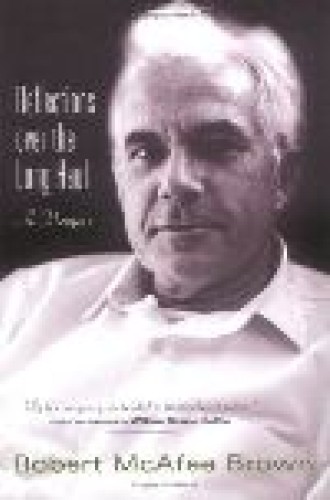The matrix
You shall be called the repairer of the breach” said Isaiah, “the restorer of the streets to live in” (58:12). Isaiah’s imploring became reality in the life of Robert McAfee Brown, a solid “repairer of the breach.” Bob Brown was also a gifted storyteller. In his carefully crafted, posthumously published memoir, his zeal for justice and his drive to make the world a better place can be seen in the stories of how this profound, humble and humorous man labored mightily to bring mercy and redemption to our common life.
Reading Brown’s memoir is like having a personal conversation with the author as he tells you how he confronted and dealt with many of the key issues of the past 50 to 60 years. If you are of sufficient age, you will relive many of the most significant events, experiences and decisions of your own life.
Brown’s academic career was a rich one; he taught on many campuses across the nation, wrote some 30 books and collected more than a dozen honorary degrees. Yet he was not content to be solely an academic. He wanted to make a difference, to embrace and participate personally in causes beyond himself.
The struggle for civil rights engaged Brown early on; as a Freedom Rider he was arrested and jailed in Tallahassee. When Cesar Chavez and the United Farm Workers needed help in Delano, California, he was there. His active opposition to the war in Vietnam led to several arrests and even imprisonment with his son Peter.
No doubt the most widely known of the Protestant ecumenists, Brown produced, with Gustav Weigel, S.J., a groundbreaking book called An American Dialogue in the early days of Protestant-Catholic rapprochement. He learned from dialogue with Latin American liberation theologians, was a member of the Holocaust Commission created by President Carter and was actively engaged in the commissions and assemblies of the World Council of Churches for many years.
Throughout his college years at Amherst and when he was in seminary, Brown considered himself a pacifist, but at the end of his years as a student at Union Seminary he determined with great anguish that he could no longer “combine concern for those in such deep distress”—he was referring to Jews in Europe—with his pacifist position. (Elie Wiesel, who was a longtime friend of Brown, said of him, “As a Jew, I saw in him the nobility of what Christianity has to offer.”)
When Brown chose to become a navy chaplain, he felt that his pacifist friends “could not help but see my defection as morally tainted.” He writes that the day he saw Nagasaki was one of the most important days of his life; there he became convinced that there is “no excuse” for dropping an atomic bomb on a city. Over the ensuing years his pacifist sympathies were once again strengthened as he observed the ways in which American power was used.
When Brown was embroiled in the congressional election campaign to save Eugene McCarthy’s seat from the Joe McCarthyites, a major door opened in his mind. He discovered that there really were liberal, intellectual Roman Catholics; it was no oxymoron. The McCarthys and the Browns became fast friends, and the Browns learned some important lessons about Roman Catholicism from them and from the monks at St. John’s Abbey in Collegeville. When he traveled to Rome during Vatican II, Brown met priests and bishops whose “self-critiques of things Roman staggered” him by their honesty. For him the council was one of “the truly significant” events of Christian history.
The Vietnam war figures large in Brown’s memoir. It was impossible, he believed, to disentangle the “human rights struggle” in the U.S. South from what was happening in Vietnam. Engaged in the peace movement both on campus and off, Brown was arrested at least four times. He helped plan the picketing and shutting down of draft boards in five Bay area cities. He accepted an invitation to speak to officers aboard a navy frigate about why he opposed the war. And as acting chaplain at Stanford he threw away his prepared 1972 Christmas Eve sermon to tell an overflow crowd that the all-out bombing President Nixon had just ordered for North Vietnam could never be justified “from the standpoint of the Christian faith”—“that it is the way of Herod, not the way of Christ.”
“Theological system-building” was not on Brown’s agenda. What he wanted was a practical theology that admitted other disciplines and concerns, incorporating sociological and economic analyses, people’s experiences and a preferential option for the poor. He insisted that much significant theology was being done in the Third World, especially in South Africa, rather than in Europe. Brown wanted a “brand-new approach to theological education,” a willingness to try out “new forms” and to have new visions. Influenced by Paulo Freire’s Pedagogy of the Oppressed, he changed his teaching style from a lecture model (“professorial imperialism”) to one that encouraged student participation.
Brown’s strong commitment to liberation theology prevailed as he worked with World Council of Churches’ assemblies in Uppsala (1968) and Nairobi (1975). When he delivered the keynote address at the Nairobi Assembly in Spanish, Christianity Today called it a cheap stunt, and Bill Buckley suggested that the U.S. should deport Brown because he disliked his nation so much. From the Latin American delegates, however, he got thanks and abrazos.
In the last four years of his remarkable life, Brown suffered from a progressive illness called Lewy body dementia. He died in 2001 in the midst of his loving family, whom he treasured and who treasured him. His friends Diana Gibson and Pia Moriarty helped him to bring this book together during his final years and made its publication possible. Interspersed with Brown’s words are reflections from his wife, his children and his grandchildren. It is impossible to come away from this book unmoved.





